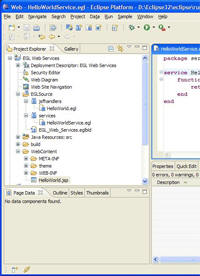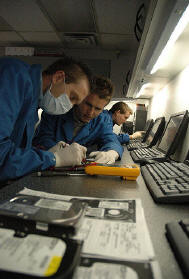Other things you can do wrong with data recovery
More on data recovery
Data recovery articles
List of Data Recovery Software
Data Protection
Related:
Disaster Recovery:
1 |
2
Backup:
1 |
2
Data Loss
Undeletion
Data Recovery Companies:
OnTrack
R-TT
Salvage Data
MJM
Runtime
ActionFront
Hard Drive Recovery
Fields Data
Recovery
Relevant DMOZ categories:
Data Recovery
Disk
Management
Elsewhere:
Data Recovery Services
Data Recovery Software
Disk Drill - mac data recovery software
Data Recovery
Free Data Recovery Software Downloads:
Free downloads center
Freebyte
SnapFiles
ACADEMIC RESEARCH - OTHER LINKS - MORE INFO
"Continuous disk-to-disk backup could shrink data recovery times to minutes or seconds,
thereby improving availability. (Today, as much as 24 hours of data could be lost since most
companies
back up data on tape drives once a day.) In addition,
backup administrators would no
longer have to worry about scheduling and managing tape resources. However, Gartner believes that at
first, successful implementations will set DPS between the primary storage and existing
backup infrastructure.
The traditional tape will back up the DPS server, rather than the individual servers.
...DPS continually logs and then replicates the byte-level changes of the files to the DPS server, then
creates snapshots on the DPS server and presents them as mountable file systems. DPS supports up to 64
of these point-in-time copies of the replicated data."
Gartner on Microsoft's
Data Recovery Software... More>>
|
|
|
 |
Data is stored on media like hard disks,
RAID configurations of hard disks, magnetic disks, tapes, CDs, DVDs, floppy disks and
other storage media. Data gets damaged or missing in a variety of ways from virus attacks to
improper storage of the media to accidents like floods. It could also have simply just been
erased. Very often a large percentage of this data can be recovered using a variety of techniques.
Recovering or salvaging the data from such media can sometimes be performed using simple
hardware or software but may occasionally require the assistance of data recovery specialists.
Some examples of data recovery:
- With optical drives there are options to repair the small nicks and scratches on the
underside of your CD/DVD. Some consumer level repair products are available from your local
PC shop. They often involve a two stage process of filling the nicks and then sealing the
surface. Done correctly this will sometimes allow reading of data that was previously inaccessible.
 - With hard disks the fault could be either mechanical/physical or logical. If the motor or
PCB (Printer Circuit Board) of the hard disk is damaged but the platters themselves (where
the data is stored) are intact then the motor/PCB could be replaced with another one. If
the mechanics are undamaged but the data has been deleted/written over or the "index" of
the files has been damaged a Hex Editor will facilitate the viewing of the drive in absolute
sector mode i.e. one sector of 512 bytes at a time. The first sector of your hard drive is
used as a partition block providing information on disk size/partitions/file system etc. And,
from there, markers to the previous "location" of your data can be found.
- With hard disks the fault could be either mechanical/physical or logical. If the motor or
PCB (Printer Circuit Board) of the hard disk is damaged but the platters themselves (where
the data is stored) are intact then the motor/PCB could be replaced with another one. If
the mechanics are undamaged but the data has been deleted/written over or the "index" of
the files has been damaged a Hex Editor will facilitate the viewing of the drive in absolute
sector mode i.e. one sector of 512 bytes at a time. The first sector of your hard drive is
used as a partition block providing information on disk size/partitions/file system etc. And,
from there, markers to the previous "location" of your data can be found.
Note: Both of these are jobs best left to people who specialise in data recovery.
- With errors in RAID configurations e.g.,
RAID 0 where data is striped (split) over two
different physical drives it is possible to recreate the RAID array and or recover the data
from each drive separately and "merge" them back to their original state.
(See
RAID data recovery)
Can erased data be recovered?
Yes, usually. When you delete a file the file is not actually deleted. It's just the entry
in the index pointing to the file's actual location that is deleted. The file itself is left
untouched but subsequent work you do on the PC could overwrite the location where the file
was so it's important to minimise any amateur attempts at data recovery.
How can I completely erase a hard disk?
You can't. Any data you've deleted can probably be recovered later. Formatting doesn't
remove the data beyond recovery. Neither does low-level formatting or "shredding".
Even when every single byte of information on your drive has been written over a lot
can still be recovered by extra sensitive recovery systems in use by the local plod
(well, maybe not him but his peers in their hi-tech departments). But, always seek
assistance at the earliest signs of trouble rather than relying on the assumption that
everything can be recovered.
Prevention
Prevention is, of course, better than finding a cure. Have a
disaster recovery plan, do frequent
backups. Keep your
backups in a different location. Test that your backups work and can restore your systems
to a fully working condition.
What you can do wrong:
1. When you think you have experienced some data loss STOP. Make a note of the last things
you did including what software was last installed on the PC, the last application you ran,
the last upgrade you did etc. It would be useful to the data recovery team. DO NOT attempt to
make changes to your data/your drive.
2. DON'T open the drive to see if you can "repair" it. These drives are usually worked on in
environments stricter than a hospital operation theatre. The smallest spec of dust getting
into the drive could render it useless.
3. Spend some time to research a good data recovery firm. Just as with any other industry
there are some cowboys around.
4. If you have a desperate need to work on whatever other data you still have on the drive
you could make a mirror (depending on the circumstances). But DON'T work on the original drive.
5. Treat the drive with kids gloves. Pack it and double pack it even more than you would a
new born baby (if you ever pack new born babies). Hard disks are sensitive to shock. A
faulty one is several times more sensitive to the smallest knock.
Free Data Recovery Software
Some data recovery software is freeware i.e., you do not need to pay for it.
Much of the rest of the industry offers free trials but with limited program
functionality (other functions are unlocked on payment of a fee). Whatever the
software, though, a potent point to remember is that when you download the
program it is best saved on a disk other than the one you hope to recover
data from or you could be permanently erasing otherwise recoverable data.
